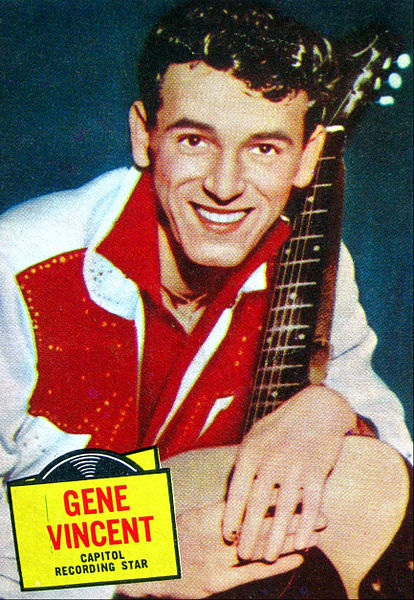Gene Vincent & The Blue Caps – Biography, Songs, Albums, Discography & Facts

QuickLinks
Gene Vincent Biography
The American rockabilly pioneer musician Gene Vincent, real name Vincent Eugene Craddock, is best known for his famous song “Be-Bop-A-Lula.”
He was born in Norfolk, Virginia, on February 11, 1935. He was exposed to gospel, country, and Rhythm and Blues music while growing up in Virginia. At the age of 12, a friend gave him his first guitar as a gift.
Gene quit school and enlisted in the Navy in 1952. He was stationed in Korea in 1955 when he was seriously injured in a motorcycle accident, breaking his left leg. The leg was preserved because he refused to have it amputated, but he was left with a limp and significant chronic pain for the remainder of his life.
After leaving the Navy, he began performing in local country bands in Norfolk, Virginia, where he was born. He co-wrote “Be-Bop-A-Lula” in 1956, which led to him and his backing band, The Blue Caps, signing a deal with Capitol Records.
Gene Vincent & the Blue Caps were unable to achieve the same level of commercial success after “Be-Bop-A-Lula,” but they did create critically regarded tunes like “Bluejean Bop” and “Race with the Devil.” In that same year, Vincent allegedly performed the racy song “Woman Love” live and was found guilty of public indecency and fined $10,000 by the state of Virginia. However, it’s now thought that this was merely a rumor.
“Lotta Lovin’,” released by the group in 1957, was another smash. Together with Jayne Mansfield, Vincent became one of the first rock stars to star in a movie with The Girl Can’t Help It.
The Blue Caps, his supporting band, saw multiple personnel changes. He left the US, nevertheless, and tried his luck in Europe due to a dispute with the US Tax Authorities and The American Musicians’ Union about payments to his band and his having sold the band’s equipment to pay a tax obligation.
Following a tour of the continent in 1959, Vincent was able to win over a new, devoted audience, particularly in England and France. His career had mostly come to an end in the US by that point. As a result, he relocated to England in 1960. His live performances were must-attend occasions, and his bands during those years produced some of the most renowned players in the modern world. At the advice of British Rock ‘n’ Roll impressario Jack Good, he first donned the recognizable leather ensemble during his early tours of Britain.
In a high-speed collision in 1960 while on tour in Britain, Vincent and singer Sharon Sheeley were in a private hire cab heading through Chippenham, Wiltshire on the A4. The Ford Consul’s blowout forced it to swerve and collide with a lamp post. Sheeley sustained a shattered pelvis, Vincent injured his ribs and collarbone, and he further damaged his already frail leg. Eddie Cochran, Sheeley’s fiancé and Vincent’s tour-mate, died in the accident, but Vincent and Sheeley both survived.
He tried to revive his American career by recording in the folk rock and country rock genres, but those efforts were unsuccessful. Today, he is most known for his recordings from the 1950s and the early 1960s, which were released on the Capitol Records label.
Gene was backed by members of The Doors, whose lead vocalist, Jim Morrison, imitated Gene’s “Leather Look,” on the album “I’m Back and I’m Proud,” which was produced for longtime supporter John Peel’s Dandelion label.
He has become a true legend, and singers and bands from all over the world admire and frequently copy his work. Be-Bop-A-Lula, his breakthrough single, is regarded as one of the three greatest rock ‘n’ roll singles of all time, solidifying Gene’s place in the annals of contemporary music. He surely would have continued to be a key character in modern rock’n’roll had he managed to survive the Punk era.
The Wild Angels, a British band that had previously performed at the Royal Albert Hall with Bill Haley & the Comets and Duane Eddy, supported him on his final tour of the UK. Gene was forced to return to the United States relatively quickly as a result of pressure from his ex-wife, the Inland Revenue, and promoter Don Arden.
While visiting his father in California, Gene Vincent passed away from a ruptured stomach ulcer. He is buried in the Eternal Valley Memorial Park in Newhall, California.
He was the inaugural member of the Rockabilly Hall of Fame when it was established in 1997. He was also posthumously admitted to the Rock & Roll Hall of Fame the following year.
Gene Vincent & The Blue Caps Discography
Top Videos
Frequently Asked Questions
What Is The Best Song Of Gene Vincent And The Blue Caps?
The best song of Gene Vincent and The Blue Caps would have to be “Be-Bop-A-Lula.” It was their first big hit and it helped put them on the map. It’s a classic rockabilly song that is still enjoyed by many fans today.
What Is The Best Selling Album Of Gene Vincent And The Blue Caps?
The best selling album of Gene Vincent and The Blue Caps is “Be-Bop-A-Lula.” It was released in 1956 and peaked at number seven on the Billboard 200 chart. The album was certified Gold by the RIAA in 1999.
What Is The First Song Of Gene Vincent And The Blue Caps?
The first song of Gene Vincent and The Blue Caps is “Be Bop a Lula”. It was released in 1956 and was a big hit. It is considered to be one of the first rock and roll songs.
How Many Albums Of Gene Vincent And The Blue Caps?
There are a total of four studio albums released by Gene Vincent and The Blue Caps. These include “Bluejean Bop” (1956), “Gene Vincent and the Blue Caps” (1957), “The Crazy World of Gene Vincent” (1958), and “Dance to the Bop” (1959). In addition to these studio albums, the band also released a number of live and compilation albums throughout the years.
